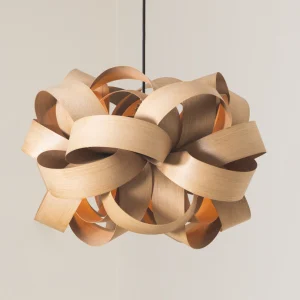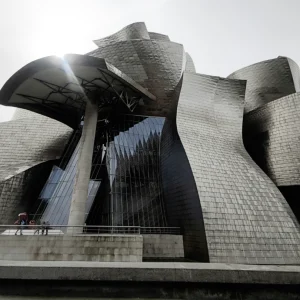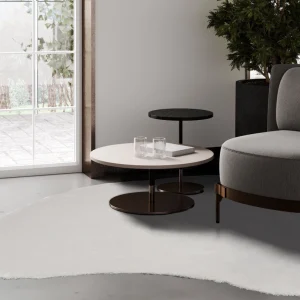PRESERVING STUDIO and maker space in London has been a losing game for the past decade, with artists repeatedly priced or pushed out of the market by speculative development and greedy landlords. A July 2023 article in The Guardian estimated that a third of visual artists in London were struggling to pay for studios. Plaster magazine, in 2024, reported that 24% of the capital’s studio space was at risk of closure. And yet one enterprising central London charity, with the support of the Mayor of London and Lewisham Council, has managed to fund and programme an ingenious refurbishment to its current building that provides vital new facilities, a greater public presence in the community, and boosts studio spaces from 60 to 80.
Cockpit Arts has been in Deptford since 2002, occupying – and, most cleverly, acquiring – a four-storey 1960s office block right by Deptford Creek. When it opened here, pretty much its only neighbours were a cluster of sturdy, brown brick, post-war local authority housing blocks – until the shimmering polycarbonate curves of the Laban Dance Centre, by Herzog & de Meuron, landed in 2003. That landmark for contemporary dance culture has long since been overshadowed by giant tower blocks of unlovely apartments, cheaply, colourfully (and mostly tastelessly) built by the usual volume housebuilders.
 The architects have made space for a purpose-built annexe along one wall, made from timber and breeze block, with red corrugated Eternit elevations. The garden designer, meanwhile, was Sebastian Cox, who’s better known for his furniture design. Photo Credit: Max Creasy
The architects have made space for a purpose-built annexe along one wall, made from timber and breeze block, with red corrugated Eternit elevations. The garden designer, meanwhile, was Sebastian Cox, who’s better known for his furniture design. Photo Credit: Max Creasy
Yet, in 2015, when developers proposed knocking down the Cockpit Arts building as part of the Sun Wharf mixed-use masterplan, Cockpit, as owner-occupiers, were in a position to resist, and recruited support from Lewisham Council on the grounds that the existing building could be reworked to offer more in the way of community education and interaction, while fostering creative enterprise and neighbourhood cohesion. To that end, it secured £1m funding from the Mayor of London’s Good Growth fund and brought architects Cooke Fawcett on board to translate those dreams into a viable design.
And what a pleasure it was to be in the new courtyard garden on opening day, 20 June, surrounded by artists, makers, neighbours, assorted press, Lewisham councillors and the architect and landscape design team.
This courtyard garden – dubbed the Craft Garden – is part of a new public welcome to the building, the ground floor façade of which was formerly a blank wall, with entrance off to one side (and this garden a disused concreted yard). The façade is now fully glazed, with multiple openable doors and windows that spill onto the courtyard, teamed with attractive, Meccano-esque perforated metal panels (to maintain security while allowing ventilation). The garden design was by Imogen McAndrew and Sebastian Cox, better known for his award winning furniture and support for environmental and craft issues. He has long been a Cockpit supporter, and this yard has provided him with his first urban landscaping project, with planting and paving inspired by the area’s fluvial geology, and flora chosen for context, botanical and professional. For example, indigenous trees of hawthorn, willow and apple have been planted with reference to their frequent use in furniture-making and basketry, and the beds are filled with cornflowers (for colour) as well as ‘dye’ plants including woad, madder and Mexican fleabane.
Fronting onto the pavement is a large, ceramic tiled wall (21×3.5m) that flanks the wide, metal mesh entrance gate. The commission for this wall was given to local-born and Cockpit-based artist Amber Khokhar, and represented her first opportunity to work at this scale. Deploying her passion for ‘sacred geometries’, these triangular tiles draw on her own memories, local folklore and historical events, as well as many workshops with the local community.
 The architects have made space for a purpose-built annexe along one wall, made from timber and breeze block, with red corrugated Eternit elevations. The garden designer, meanwhile, was Sebastian Cox, who’s better known for his furniture design. Photo Credit: Max Creasy
The architects have made space for a purpose-built annexe along one wall, made from timber and breeze block, with red corrugated Eternit elevations. The garden designer, meanwhile, was Sebastian Cox, who’s better known for his furniture design. Photo Credit: Max Creasy
Titled Head, Heart, Hand, the work comprises 1,300 tiles, including 100 hand-drawn illustrations celebrating the area’s significant events and celebrities; other tiles spell out ‘head, heart, hand’ in the 40 or so languages most frequently spoken in Deptford’s streets, from Bengali to Polish. ‘Every triangle has a story to it,’ she told us at the opening.
Cooke Fawcett worked closely with the 60-plus resident makers and microbusinesses to identify which qualities in the existing concrete frame building were most useful and how they could be improved. For the most part, the original, cellular, 1960s office layouts on the first, second and third floors, have worked well for makers, with dual-aspect glazing thanks to a glazed interior corridor surrounding the large back yard. Here, parking for bikes and cars has been maintained, while the architects have made space for a purpose built 86m2 annexe along one wall. This timber and breeze block structure, with red corrugated Eternit elevations, now provides Cockpit makers with a state-of-the-art woodworking space. One half comprises shared space, with heavy machinery and kit pooled between the studios, and a linear plan to accommodate long planks of timber. The other half provides a dedicated studio for renowned wood sculptor Eleanor Lakelin.
A key move, however, was bringing education space down from its cramped quarters on the first floor to a large and airy room on the ground floor, adjacent to and easily accessed from the foyer, which combines flexible café, event and gallery space. This education space not only expands the capacity and appeal of Cockpit Arts existing workshops and outreach, including the centre’s regular National Saturday Club for 13 to 16-year-olds, but also enhances opportunities for makers to run their own workshops, events and seminars.
More maker space was created on the first floor through a move of education facilities, as well as through the reclaiming of surplus toilet provision. Meanwhile, downstairs, a new leather workshop is also provided for the 12 Cockpit tenants who work with leather; they can now rely on the finest leatherworking machinery supplied by the Leather-sellers Foundation. Cockpit Arts maintains vital relationships with the various crafts guilds through its activities on this site and its original one in Bloomsbury, as well as business support and mentoring to its community of makers. Now it is not just one of the biggest providers of affordable studio space in the city but, with this new, public facing facility in Deptford, it can truly build on CEO Jonathan Burton’s stated ambition ‘to communicate the benefit of craft and creativity to a wider audience’.





